The Application of Ionic Liquids in the Lubrication Field: Their Design, Mechanisms, and Behaviors
Abstract
:1. Introduction
2. The Relationship between the Physical and Chemical Properties of ILs and Their Molecular Structures
2.1. Viscosity
2.2. Corrosion Property
2.3. Thermal Stability
- (1)
- The anion type has the greatest influence on the thermal stability of ILs, and then the cation type, while cation modification has the least effect [31,32]. Among them, the difference of nucleophilic properties caused by the anion type is an important reason for affecting the thermal stability of ILs. A nucleophilic substitution reaction is an important way of ILs’ decomposition. The stronger the nucleophilic properties of anions, the more likely a nucleophilic substitution reaction is to occur, leading to the decomposition of the IL; thus, the worse the thermal stability of the IL. The thermal stability order of common anions is as follows: [31]. Additionally, the anion type can affect the location of the nucleophilic reaction and then affect the decomposition path of the ILs, resulting in differences in the thermal stability of the ILs. Zhang et al. analyzed the short-term thermal stability and decomposition mechanism of 1-butyl-3-methyl-imidazole bis(trifluoromethylsulfonyl)imine ([BMIM][Tf2N]), 1-butyl-3-methyl-imidazole acetate ([BMIM][Ac]) and 1-butyl-3-methyl-imidazole tetrafluoroborate ([BMIM][BF4]. There were one and two locations for and , respectively, where nucleophilic reactions could occur, corresponding to one and two decomposition pathways. The decomposition pathway of was the most complicated. The short-term thermal stability of the three ILs followed the following order: [BMIM] [Ac] < [BMIM][BF4] < [BMIM][Tf2N]. It was proposed that the more complex the decomposition mechanism of the ILs, the better the thermal stability [33].
- (2)
- (3)
- (4)
- The influence of different group-functionalized cations or anions on the thermal stability of ILs is also significantly different. For example, allyl-functionalization would decrease the thermal stability of ILs. Meanwhile, for hydroxyl functionalization, the thermal stability depends on the anion type [34].
2.4. Conductivity
3. The Lubrication Mechanisms and Behaviors of ILs
3.1. ILs Used as Base Lubricants
3.2. ILs Used as Oil-Based Additives
3.3. ILs Used as Water-Based Additives
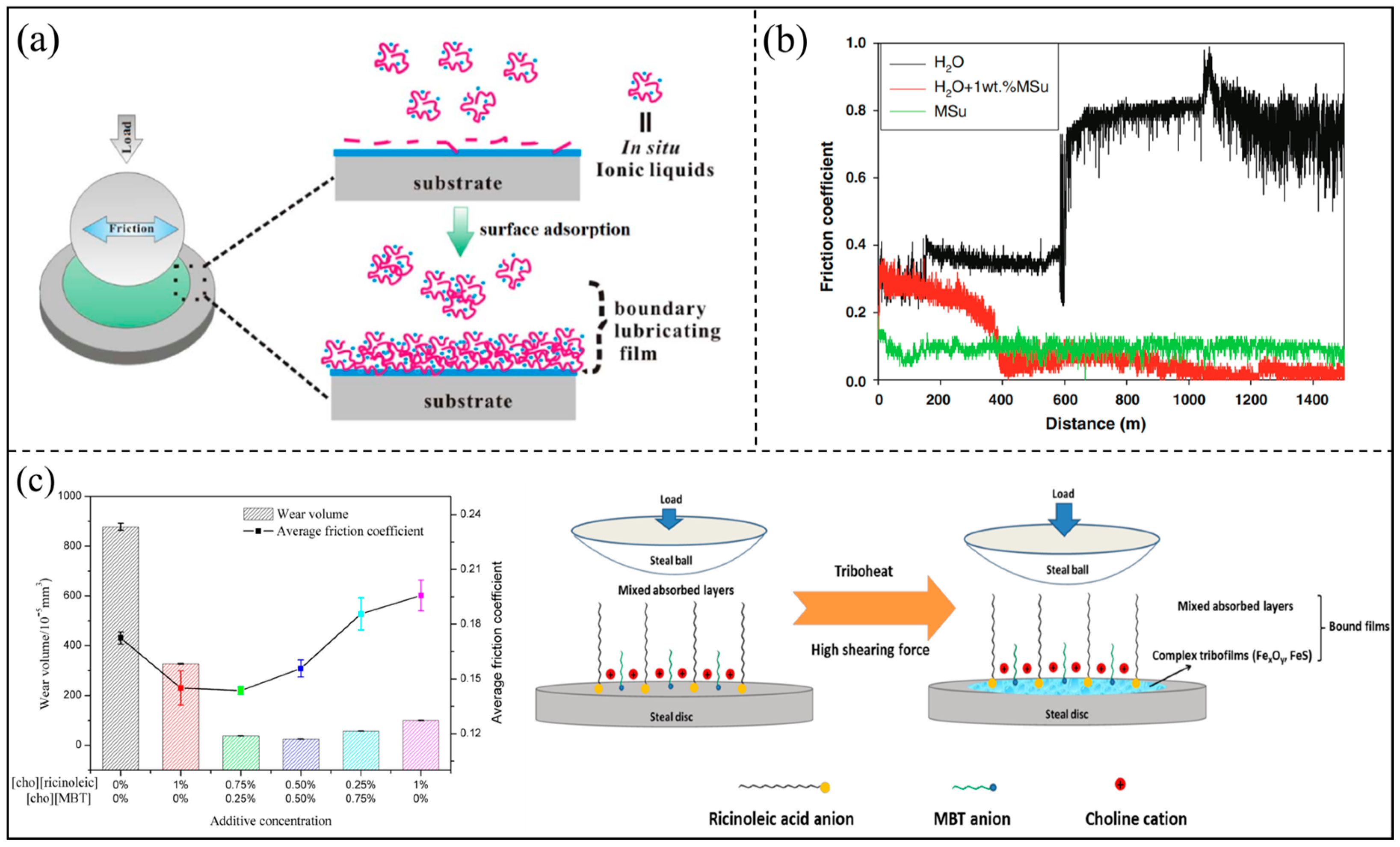
3.4. The Tribological Behaviors of ILs in Response to External Electric Fields
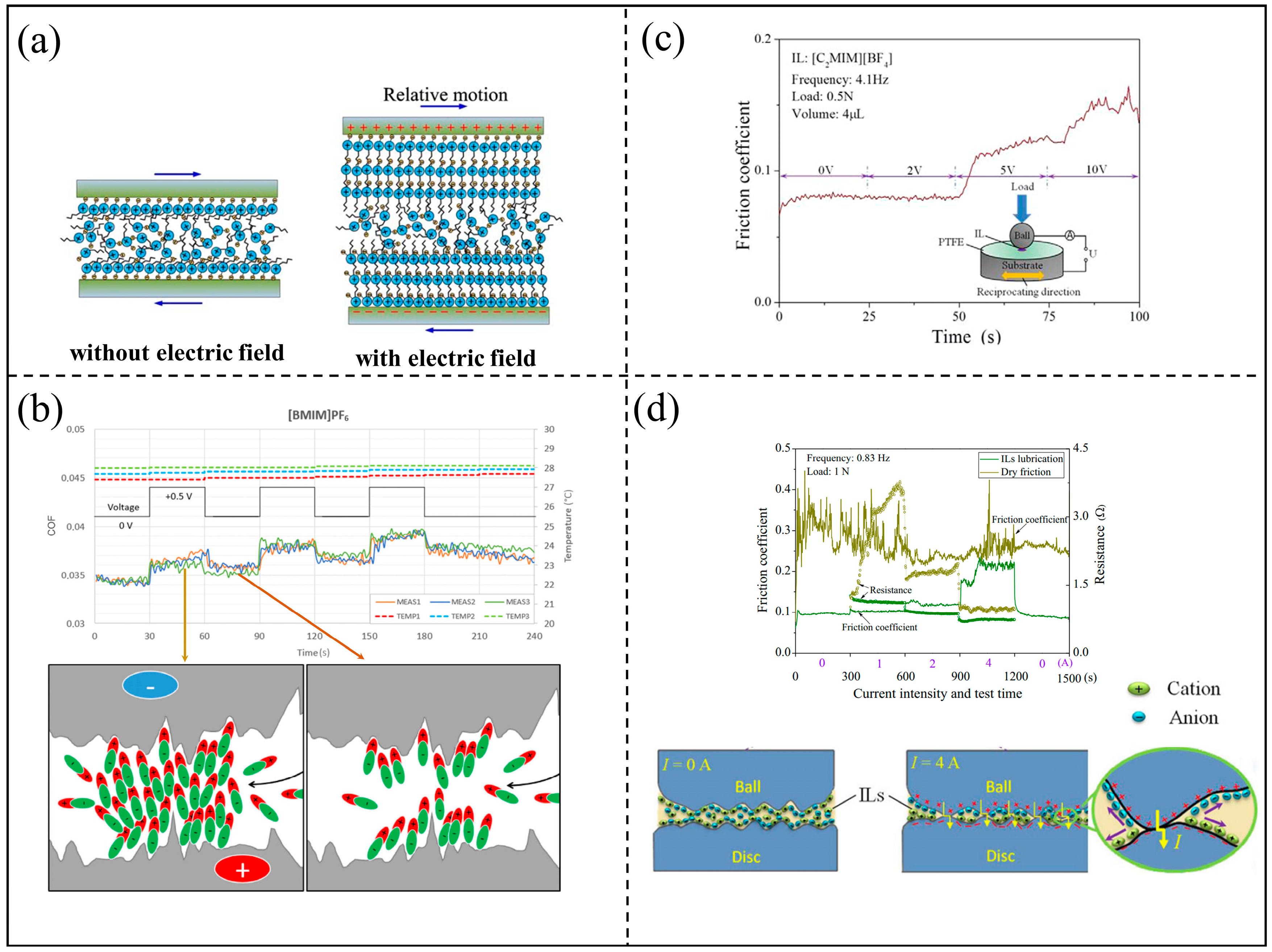
4. Conclusions
- (1)
- When ILs are used as base lubricants, lubrication films can form on the surface through physical adsorption and tribo-chemical reactions. Two forms of lubrication film can exist at the same time to reduce friction and wear and improve the load bearing. In addition, the material of friction pairs and the molecular inclination of the ILs on the surface cannot be ignored.
- (2)
- When ILs are used as oil-based lubricant additives, the interaction between the ILs and the material surface, the base lubricant, and the other additives can significantly improve the surface friction state. The interaction between ILs and the surface is mainly manifested as the formation of lubricating films. The interaction between ILs and the base lubricating oil or other lubricant additives is mainly in the form of coordination or competition.
- (3)
- Corrosion and poor film-forming ability are two major obstacles to the practical application of water-based lubricants. The addition of ILs can avoid the surface corrosion of water-based lubricants by forming a physical adsorption film on the surface that prevents direct contact between water molecules and the surface, forming a corrosion-resistant coating during friction and interrupting the chain reaction of corrosion. The preparation of ILs in situ and the combined use of various additives were put forward to improve the film-forming ability of water-based lubricants from the aspects of process and material.
- (4)
- The conductivity property of ILs makes them have the potential to become intelligent lubricating materials. The external electric field can change the viscosity, the arrangement order on the surface, and the film thickness of ILs, so as to realize the real-time adjustment of the friction coefficient.
Author Contributions
Funding
Data Availability Statement
Conflicts of Interest
References
- Perez-Martinez, C.S.; Perkin, S. Interfacial Structure and Boundary Lubrication of a Dicationic Ionic Liquid. Langmuir 2019, 35, 15444–15450. [Google Scholar] [CrossRef] [PubMed]
- Borghi, F.; Milani, P.; Podestà, A. Solid-Like Ordering of Imidazolium-Based Ionic Liquids at Rough Nanostructured Oxidized Silicon Surfaces. Langmuir 2019, 35, 11881–11890. [Google Scholar] [CrossRef] [PubMed]
- Liu, W.R.; Wang, H.D.; Liu, Y.H. Adjustable superlubricity system using polyalkylene glycol with various acid aqueous solutions. Friction 2023, 11, 1138–1149. [Google Scholar] [CrossRef]
- Qiao, Y.J.; Song, J.; Shi, H.Y.; Wang, H.D.; Wen, S.Z.; Liu, Y.H. Hierarchical self-assembled structure and frictional response of phthalocyanine molecules. Friction 2023, 11, 354–368. [Google Scholar] [CrossRef]
- Wang, Y.L.; Li, L. Uncovering the Underlying Mechanisms Governing the Solidlike Layering of Ionic Liquids (ILs) on Mica. Langmuir 2020, 36, 2743–2756. [Google Scholar] [CrossRef]
- Tu, W.K.; Chat, K.; Szklarz, G.; Laskowski, L.; Grzybowska, K.; Paluch, M.; Richert, R.; Adrjanowicz, K. Dynamics of Pyrroli-dinium-Based Ionic Liquids Under Confinement. II. The Effects of Pore Size, Inner Surface, and Cationic Alkyl Chain Length. J. Phys. Chem. C 2019, 124, 5395–5408. [Google Scholar] [CrossRef]
- Ye, C.F.; Liu, W.M.; Chen, Y.X.; Yu, L.G. Room-temperature ionic liquids: A novel versatile lubricant. Chem. Commun. 2001, 21, 2244–2245. [Google Scholar] [CrossRef]
- Victor, V.d.C.; Leonardo, M.d.S.; Leonardo, M.A.; Roberto, M.S.; Silvana, M.; Klester, S.S.; Marcelo, B.P.; Cleber, R.d.L.L.; Sandra, E.; Carlos, A.d.S.; et al. A Tribological and Electrochemical Study of Protic Ionic Liquid and Bentonite Particles Used as Lubricating Additives in Water-Based Lubricants. J. Bio-Tribo-Corros. 2023, 9, 51. [Google Scholar]
- Guo, H.; Adukure, A.R.; Iglesias, P. Effect of Ionicity of Three Protic Ionic Liquids as Neat Lubricants and Lubricant Additives to a Biolubricant. Coatings 2019, 9, 713. [Google Scholar] [CrossRef]
- Lebedeva, O.; Kultin, D.; Kustov, L. Advanced research and prospects on polymer ionic liquids: Trends, potential and application. Green Chem. 2023, 25, 9001–9019. [Google Scholar] [CrossRef]
- Ramezani, M.; Ripin, Z.M.; Jiang, C.; Pasang, T. Superlubricity of Materials: Progress, Potential, and Challenges. Materials 2023, 16, 5145. [Google Scholar] [CrossRef] [PubMed]
- Cao, Z.F.; Xia, Y.Q.; Liu, L.H.; Feng, X. Study on the conductive and tribological properties of copper sliding electrical contacts lubricated by ionic liquids. Tribol. Int. 2018, 130, 27–35. [Google Scholar] [CrossRef]
- Yang, X.Y.; Meng, Y.G.; Tian, Y. Effect of Imidazolium Ionic Liquid Additives on Lubrication Performance of Propylene Carbonate under Different Electrical Potentials. Tribol. Lett. 2014, 56, 161–169. [Google Scholar] [CrossRef]
- Wang, J.M.; Wang, J.H.; Li, C.S.; Zhao, G.Q.; Wang, X.B. A study of 2,5-dimercapto-1,3,4-thiadiazole derivatives as multifunc-tional additives in water-based hydraulic fluid. Ind. Lubr. Tribol. 2014, 66, 402–410. [Google Scholar] [CrossRef]
- Sadanandhan, A.M.; Khatri, P.K.; Jain, S.L. A novel series of cyclophosphazene derivatives containing imidazolium ionic liquids with variable alkyl groups and their physicochemical properties. J. Mol. Liq. 2019, 295, 111722. [Google Scholar] [CrossRef]
- Sernaglia, M.; Blanco, D.; Battez, A.H.; Viesca, J.L.; González, R.; Bartolomé, M. Two fatty acid anion-based ionic liquids—Part I: Physicochemical properties and tribological behavior as neat lubricants. J. Mol. Liq. 2020, 305, 112827. [Google Scholar] [CrossRef]
- Gusain, R.; Dhingra, S.; Khatri, O.P. Fatty-Acid-Constituted Halogen-Free Ionic Liquids as Renewable, Environmentally Friendly, and High-Performance Lubricant Additives. Ind. Eng. Chem. Res. 2016, 55, 856–865. [Google Scholar] [CrossRef]
- Zhang, X.C.; Huo, F.; Liu, X.M.; Dong, K.; He, H.Y.; Yao, X.Q.; Zhang, S.J. Influence of Microstructure and Interaction on Viscosity of Ionic Liquids. Ind. Eng. Chem. Res. 2015, 54, 3505–3514. [Google Scholar] [CrossRef]
- Khan, A.; Gusain, R.; Khatri, O.P. Organophosphate anion based low viscosity ionic liquids as oil-miscible additives for lubrication enhancement. J. Mol. Liq. 2018, 272, 430–438. [Google Scholar] [CrossRef]
- Han, Y.Y.; Qiao, D.; Zhang, S.W.; Feng, D.P. Influence of phosphate and phosphonate ionic liquid structures on lubrication for different alloys (Mg, Al, Cu). Tribol. Int. 2017, 114, 469–477. [Google Scholar] [CrossRef]
- Gusain, R.; Khatri, O.P. Fatty acid ionic liquids as environmentally friendly lubricants for low friction and wear. RSC Adv. 2016, 6, 3462–3469. [Google Scholar] [CrossRef]
- Verma, D.K.; Dewangan, Y.; Singh, A.K.; Mishra, R.; Susan, M.A.; Salim, R.; Taleb, M.; El Hajjaji, F.; Berdimurodov, E. Ionic liquids as green and smart lubricant application: An overview. Ionics 2022, 28, 4923–4932. [Google Scholar] [CrossRef]
- Gusain, R.; Gupta, P.; Saran, S.; Khatri, O.P. Halogen-Free Bis(imidazolium)/Bis(ammonium)-Di[bis(salicylato)borate] Ionic Liquids as Energy-Efficient and Environmentally Friendly Lubricant Additives. ACS Appl. Mater. Inter. 2014, 6, 15318–15328. [Google Scholar] [CrossRef] [PubMed]
- Gusain, R.; Khatri, O.P. Halogen-free ionic liquids: Effect of chelated orthoborate anion structure on their lubrication properties. RSC Adv. 2015, 5, 25287–25294. [Google Scholar] [CrossRef]
- Khan, A.; Yasa, S.R.; Gusain, R.; Khatri, O.P. Oil-miscible, halogen-free, and surface-active lauryl sulphate-derived ionic liquids for enhancement of tribological properties. J. Mol. Liq. 2020, 318, 114005. [Google Scholar] [CrossRef]
- Totolin, V.; Minami, I.; Gabler, C.; Döorr, N. Halogen-free borate ionic liquids as novel lubricants for tribological applications. Tribol. Int. 2013, 67, 191–198. [Google Scholar] [CrossRef]
- Kondo, Y.; Koyama, T.; Tsuboi, R.; Nakano, M.; Miyake, K.; Sasaki, S. Tribological Performance of Halogen-Free Ionic Liquids as Lubricants of Hard Coatings and Ceramics. Tribol. Lett. 2013, 51, 243–249. [Google Scholar] [CrossRef]
- Itoh, T.; Watanabe, N.; Inada, K.; Ishioka, A.; Hayase, S.; Kawatsura, M.; Minami, I.; Mori, S. Design of Alkyl Sulfate Ionic Liquids for Lubricants. Chem. Lett. 2009, 38, 64–65. [Google Scholar] [CrossRef]
- Westerholt, A.; Weschta, M.; Boesmann, A.; Tremmel, S.; Korth, Y.; Wolf, M.; Schluecker, E.; Wehrum, N.; Lennert, A.; Uerdingen, M.; et al. Halide-Free Synthesis and Tribological Performance of Oil-Miscible Ammonium and Phosphonium-Based Ionic Liquids. ACS Sustain. Chem. Eng. 2015, 3, 797–808. [Google Scholar] [CrossRef]
- Han, Y.Y.; Qiao, D.; Sun, L.M.; Feng, D.P. Functional alkylimidazolium ionic liquids as lubricants for steel/aluminum contact: Influence of the functional groups on tribological performance. Tribol. Int. 2018, 119, 766–774. [Google Scholar] [CrossRef]
- Maton, C.; De Vos, N.; Stevens, C.V. Ionic liquid thermal stabilities: Decomposition mechanisms and analysis tools. Chem. Soc. Rev. 2013, 42, 5963–5977. [Google Scholar] [CrossRef] [PubMed]
- Siedlecka, E.M.; Czerwicka, M.; Stolte, S.; Stepnowski, P. Stability of Ionic Liquids in Application Conditions. J. Org. Chem. 2011, 15, 1974–1991. [Google Scholar] [CrossRef]
- Zhang, L.Y.; Liu, S.H.; Wang, Y. Exploring the influence of the type of anion in imidazolium ionic liquids on its thermal stability. J. Therm. Anal. Calorim. 2023, 148, 4985–4995. [Google Scholar] [CrossRef]
- Cao, Y.Y.; Mu, T.C. Comprehensive Investigation on the Thermal Stability of 66 Ionic Liquids by Thermogravimetric Analysis. Ind. Eng. Chem. Res. 2014, 53, 8651–8664. [Google Scholar] [CrossRef]
- Yao, M.H.; Liang, Y.M.; Xia, Y.Q.; Zhou, F.; Liu, X.Q. High-Temperature Tribological Properties of 2-Substituted Imidazolium Ionic Liquids for Si3N4-Steel Contacts. Tribol. Lett. 2008, 32, 73–79. [Google Scholar] [CrossRef]
- Pagano, F.; Gabler, C.; Zare, P.; Mahrova, M.; Dörr, N.; Bayon, R.; Fernandez, X.; Binder, W.H.; Hernaiz, M.; Tojo, E.; et al. Dicationic ionic liquids as lubricants. Proc. Inst. Mech. Eng. Part J J. Eng. Tribol. 2012, 226, 952–964. [Google Scholar] [CrossRef]
- Hapiot, P.; Lagrost, C. Electrochemical Reactivity in Room-Temperature Ionic Liquids. Chem. Rev. 2008, 108, 2238–2264. [Google Scholar] [CrossRef]
- De Santis, S.; Masci, G.; Casciotta, F.; Caminiti, R.; Scarpellini, E.; Campetella, M.; Gontrani, L. Cholinium-amino acid based ionic liquids: A new method of synthesis and physico-chemical characterization. Phys. Chem. Chem. Phys. 2015, 17, 20687–20698. [Google Scholar] [CrossRef]
- Ueno, K.; Tokuda, H.; Watanabe, M. Ionicity in ionic liquids: Correlation with ionic structure and physicochemical properties. Phys. Chem. Chem. Phys. 2010, 12, 1649–1658. [Google Scholar] [CrossRef]
- Zhang, S.G.; Shi, R.; Ma, X.Y.; Lu, L.J.; He, Y.D.; Zhang, X.H.; Wang, Y.T.; Deng, Y.Q. Intrinsic Electric Fields in Ionic Liquids Determined by Vibrational Stark Effect Spectroscopy and Molecular Dynamics Simulation. Chem-Eur. J. 2012, 18, 11904–11908. [Google Scholar] [CrossRef]
- Tao, D.J.; Cheng, Z.; Chen, F.F.; Li, Z.M.; Hu, N.; Chen, X.S. Synthesis and Thermophysical Properties of Biocompatible Cho-linium-Based Amino Acid Ionic Liquids. J. Chem. Eng. Data 2013, 58, 1542–1548. [Google Scholar] [CrossRef]
- Elbourne, A.; Vo Tchovsky, K.; Warr, G.G.; Atkin, R. Ion structure controls ionic liquid near-surface and interfacial nanostructure. Chem. Sci. 2014, 6, 527–536. [Google Scholar] [CrossRef] [PubMed]
- Zhou, Y.; Leonard, D.N.; Guo, W.; Qu, J. Understanding Tribofilm Formation Mechanisms in Ionic Liquid Lubrication. Sci. Rep. 2017, 7, 8426. [Google Scholar] [CrossRef] [PubMed]
- Yao, M.H.; Fan, M.J.; Liang, Y.M.; Zhou, F.; Xia, Y.Q. Imidazolium hexafluorophosphate ionic liquids as high temperature lubricants for steel–steel contacts. Wear 2010, 268, 67–71. [Google Scholar] [CrossRef]
- Xiao, H.P.; Guo, D.; Liu, S.H.; Pan, G.S.; Lu, X.C. Film Thickness of Ionic Liquids Under High Contact Pressures as a Function of Alkyl Chain Length. Tribol. Lett. 2011, 41, 471–477. [Google Scholar] [CrossRef]
- Tariq, M.; Serro, A.P.; Colaço, R.; Saramago, B.; Lopes, J.N.C.; Rebelo, L.P.N. Effect of alkyl chain length on the adsorption and frictional behaviour of 1-alkyl-3-methylimidazolium chloride ionic liquid surfactants on gold surfaces. Colloids Surf. A Physicochem. Eng. Asp. 2011, 377, 361–366. [Google Scholar] [CrossRef]
- Smith, A.M.; Lovelock, K.R.J.; Gosvami, N.N.; Welton, T.; Perkin, S. Quantized friction across ionic liquid thin films. Phys. Chem. Chem. Phys. 2013, 15, 15317–15320. [Google Scholar] [CrossRef]
- Han, Y.Y.; Hao, D.; Gao, P.; Wen, P.; Fan, M.J. Tailoring an inorganic-organic double layer tribofilm for high-performance ionic liquid magnesium alloy lubricants. Tribol. Int. 2023, 179, 108197. [Google Scholar] [CrossRef]
- Somers, A.E.; Khemchandani, B.; Howlett, P.C.; Sun, J.; Macfarlane, D.R.; Forsyth, M. Ionic liquids as antiwear additives in base oils: Influence of structure on miscibility and antiwear performance for steel on aluminum. ACS Appl. Mater. Inter. 2013, 5, 11544–11553. [Google Scholar] [CrossRef]
- Wen, S.Z.; Huang, P. Principles of Tribology, 2nd ed.; Tsinghua University Press: Beijing, China, 2017; pp. 305–306. [Google Scholar]
- Kondo, Y.; Yagi, S.; Koyama, T.; Tsuboi, R.; Sasaki, S. Lubricity and corrosiveness of ionic liquids for steel-on-steel sliding con-tacts. P. I Mech. Eng. 2012, 226, 991–1006. [Google Scholar]
- Zhang, L.; Feng, D.P.; Xu, B. Tribological Characteristics of Alkylimidazolium Diethyl Phosphates Ionic Liquids as Lubricants for Steel–Steel Contact. Tribol. Lett. 2009, 34, 95–101. [Google Scholar] [CrossRef]
- Jiang, D.; Hu, L.T.; Feng, D.P. Tribological behaviors of novel crown-type phosphate ionic liquids as lubricants for steel/aluminum contacts. Ind. Lubr. Tribol. 2013, 65, 219–225. [Google Scholar] [CrossRef]
- Watanabe, S.; Nakano, M.; Miyake, K.; Tsuboi, R.; Sasaki, S. Effect of Molecular Orientation Angle of Imidazolium Ring on Fric-tional Properties of Imidazolium-Based Ionic Liquid. Langmuir 2014, 30, 8078–8084. [Google Scholar] [CrossRef] [PubMed]
- Calandra, P.; Szerb, E.I.; Lombardo, D.; Algieri, V.; Maiuolo, L. A Presentation of Ionic Liquids as Lubricants: Some Critical Comments. Appl. Sci. 2021, 11, 5677. [Google Scholar] [CrossRef]
- Andriuis, A. Tribological Properties of Protic Ionic Liquid as an Additive in Aqueous Glycerol Solution for Ruby-Bearing Steel Tribo-Contact. Lubricants 2023, 11, 34. [Google Scholar]
- Guo, R.I.P. Influence of Hydrogen Bonding and Ionicity of Protic Ionic Liquids on Lubricating Steel-Steel and Steel-Aluminum Contacts: Potential Ecofriendly Lubricants and Additives. Tribol. Lett. 2020, 68, 114. [Google Scholar] [CrossRef]
- Kronberger, M.; Pejaković, V.; Gabler, C.; Kalin, M. How anion and cation species influence the tribology of a green lubricant based on ionic liquids. Proc. Inst. Mech. Eng. Part J J. Eng. Tribol. 2012, 226, 933–951. [Google Scholar] [CrossRef]
- Pejaković, V.; Kronberger, M.; Mahrova, M.; Vilas, M.; Tojo, E.; Kalin, M. Pyrrolidinium sulfate and ammonium sulfate ionic liquids as lubricant additives for steel/steel contact lubrication. Proc. Inst. Mech. Eng. Part J J. Eng. Tribol. 2012, 226, 923–932. [Google Scholar] [CrossRef]
- Bakshi, P.S.; Gusain, R.; Dhawaria, M.; Suman, S.K.; Khatri, O.P. Antimicrobial and lubrication properties of 1-acetyl-3-hexylbenzotriazolium benzoate/sorbate ionic liquids. RSC Adv. 2016, 6, 46567–46572. [Google Scholar] [CrossRef]
- Pejakovi, V.; Tomastik, C.; Drr, N.; Kalin, M. Influence of concentration and anion alkyl chain length on tribological properties of imidazolium sulfate ionic liquids as additives to glycerol in steel-steel contact lubrication. Tribol. Int. 2016, 97, 234–243. [Google Scholar] [CrossRef]
- Kawada, S.; Sasaki, S.; Miyatake, M. In-situ observation of tribo-decomposition behavior of ionic liquids composed of phosphonium-cation and cyano-anion using quadrupole mass spectrometer. Tribol. Int. 2021, 153, 106547. [Google Scholar] [CrossRef]
- Qu, J.; Truhan, J.J.; Dai, S.; Luo, H.; Blau, P.J. Ionic liquids with ammonium cations as lubricants or additives. Tribol. Lett. 2006, 22, 207–214. [Google Scholar] [CrossRef]
- Viesca, J.L.; García, A.; Battez, A.H.; González, R.; Monge, R.; Fernández-González, A.; Hadfield, M. FAP- Anion Ionic Liquids Used in the Lubrication of a Steel-Steel Contact. Tribol. Lett. 2013, 52, 431–437. [Google Scholar] [CrossRef]
- Hernández Battez, A.; González, R.; Viesca, J.L.; Fernández-González, A.; Hadfield, M. Lubrication of PVD coatings with ethyl-dimethyl-2-methoxyethylammonium tris(pentafluoroethyl)trifluorophosphate. Tribol. Int. 2013, 58, 71–78. [Google Scholar] [CrossRef]
- Pejakovic, V.; Kalin, M. Frictional behaviour of imidazolium sulfate ionic liquid additives under mixed slide-to-roll conditions: Part 1 Variation of mixtures with identical weight ratio of ionic liquid additive. Lubr. Sci. 2015, 27, 463–477. [Google Scholar] [CrossRef]
- Khatri, P.K.; Aathira, M.S.; Thakre, G.D.; Jain, S.L. Synthesis and tribological behavior of fatty acid constituted tetramethylguanidinium (TMG) ionic liquids for a steel/steel contact. Mat. Sci. Eng. C-Mater. 2018, 91, 208–217. [Google Scholar] [CrossRef]
- Zhao, L.N.; Cai, T.; Zhang, Y.X.; Ye, M.T.; Shang, W.J.; Liu, D.; Tong, D.Y.; Liu, S.G. Synthesis, characterization and tribological evaluation of novel 1,4-diazabicyclo[2.2.2]octane based dicationic ionic liquids as efficient antiwear lubricant additives. Sci. China Technol. Sci. 2019, 62, 252–262. [Google Scholar] [CrossRef]
- Yu, Q.L.; Wang, Y.R.; Huang, G.W.; Ma, Z.F.; Shi, Y.J.; Cai, M.R.; Zhou, F.; Liu, W.M. Task-Specific Oil-Miscible Ionic Liquids Lubricate Steel/Light Metal Alloy: A Tribochemistry Study. Adv. Mater. Interfaces 2018, 5, 1800791. [Google Scholar] [CrossRef]
- Lv, S.C.; Chen, T.; Wang, T.T.; Li, Y.; Gao, X.L. Friction-reducing properties of N-containing ionic liquid additives by using quantitative structure tribo-ability relationship model. J. Disper Sci. Technol. 2020, 43, 620–627. [Google Scholar] [CrossRef]
- Qiao, D.; Wang, H.Z.; Feng, D.P. Tribological Performance and Mechanism of Phosphate Ionic Liquids as Additives in Three Base Oils for Steel-on-aluminum Contact. Tribol. Lett. 2014, 55, 517–531. [Google Scholar] [CrossRef]
- Han, Y.Y.; Qiao, D.; Guo, Y.X.; Feng, D.P.; Shi, L. Influence of Competitive Adsorption on Lubricating Property of Phosphonate Ionic Liquid Additives in PEG. Tribol. Lett. 2016, 64, 22. [Google Scholar] [CrossRef]
- Kheireddin, B.A.; Lu, W.; Chen, I.; Akbulut, M. Inorganic nanoparticle-based ionic liquid lubricants. Wear 2013, 303, 185–190. [Google Scholar] [CrossRef]
- Wei, X.Y.; Zhao, Y.; Zhang, L.X.; Wang, J.H.; Wang, L.Y.; Xi, D.Y. Effects of ionic liquid on the dispersion and tribological property of graphene lubricant. Lubr. Sci. 2020, 32, 415–423. [Google Scholar] [CrossRef]
- Zhang, Y.X.; Cai, T.; Shang, W.J.; Sun, L.W.; Liu, D.; Tong, D.Y.; Liu, S.G. Environmental friendly polyisobutylene-based ionic liquid containing chelated orthoborate as lubricant additive: Synthesis, tribological properties and synergistic interactions with ZDDP in hydrocarbon oils. Tribol. Int. 2017, 115, 297–306. [Google Scholar] [CrossRef]
- Ma, L.R.; Zhang, C.H.; Liu, S.H. Progress in experimental study of aqueous lubrication. Chin. Sci. Bull. 2012, 57, 2062–2069. [Google Scholar] [CrossRef]
- Wang, J.M.; Wang, J.H.; Li, C.S.; Zhao, G.Q.; Wang, X.B. Tribological performance of poly(sodium 4-styrenesulphonate) as additive in water-glycol hydraulic fluid. Lubr. Sci. 2012, 24, 140–151. [Google Scholar] [CrossRef]
- Rahman, M.H.; Warneke, H.; Webbert, H.; Rodriguez, J.; Austin, E.; Tokunaga, K.; Rajak, D.K.; Menezes, P.L. Water-Based Lubricants: Development, Properties, and Performances. Lubricants 2021, 9, 73. [Google Scholar] [CrossRef]
- Zhang, C.L.; Zhang, S.M.; Yu, L.G.; Zhang, Z.J.; Wu, Z.S.; Zhang, P.Y. Preparation and tribological properties of water-soluble copper/silica nanocomposite as a water-based lubricant additive. Appl. Surf. Sci. 2012, 259, 824–830. [Google Scholar] [CrossRef]
- Yang, Z.Q.; Sun, C.F.; Zhang, C.Y.; Zhao, S.J.; Cai, M.R.; Liu, Z.L.; Yu, Q.L. Amino acid ionic liquids as anticorrosive and lubricating additives for water and their environmental impact. Tribol. Int. 2021, 153, 106663. [Google Scholar] [CrossRef]
- Xu, F.; Li, H.; Tian, B.; Cui, K.; Dong, R.; Fan, M.; Cai, M.; Zhou, F.; Liu, W. Achieving Greener, Super-Robust Performance Water-Based Lubrication: Obtained by a Multifunctional Ionic Liquid Aqueous System and Formation of Unique Interfacial Inter-actions. ACS Sustain. Chem. Eng. 2023, 11, 8651–8666. [Google Scholar] [CrossRef]
- Chen, G.; Zhang, C.; Huang, Q.; Yu, Q.; Yang, Z.; Zhou, C.; Yan, X.; Wang, R.; Yu, B.; Cai, M. Novel Phosphate Organic Guan-idine Salt Water-Based Additive with Integrated Anti-Friction, Anti-Wear and Anti-Corrosion Properties. Tribol. Lett. 2022, 70, 33. [Google Scholar] [CrossRef]
- Dong, R.; Yu, Q.; Bai, Y.; Wu, Y.; Cai, M. Towards superior lubricity and anticorrosion performances of proton-type ionic liquids additives for water-based lubricating fluids. Chem. Eng. J. 2019, 383, 123201. [Google Scholar] [CrossRef]
- Yu, Q.L.; Yang, Z.Q.; Huang, Q.; Lv, H.Y.; Zhou, K.; Yan, X.Y.; Wang, X.W.; Yang, W.F.; Zhou, C.Y.; Yu, B.; et al. Lignin composite ionic liquid lubricating material as a water-based lubricating fluid additive with excellent lubricating, anti-wear and anti-corrosion properties. Tribol. Int. 2022, 174, 107742. [Google Scholar] [CrossRef]
- Avilés, M.D.; Carrión-Vilches, F.J.; Sanes, J.; Bermúdez, M.D. Diprotic Ammonium Succinate Ionic Liquid in Thin Film Aqueous Lubrication and in Graphene Nanolubricant. Tribol. Lett. 2019, 67, 26. [Google Scholar] [CrossRef]
- Dong, R.; Bao, L.Y.; Yu, Q.L.; Wu, Y.; Ma, Z.F.; Zhang, J.Y.; Cai, M.R.; Zhou, F.; Liu, W.M. Effect of Electric Potential and Chain Length on Tribological Performances of Ionic Liquids as Additives for Aqueous Systems and Molecular Dynamics Simulations. ACS Appl. Mater. Inter. 2020, 12, 39910–39919. [Google Scholar] [CrossRef]
- Zheng, Z.; Liu, X.; Yu, H.; Chen, H.; Feng, D.; Qiao, D. Insight into macroscale superlubricity of polyol aqueous solution in-duced by protic ionic liquid. Friction 2022, 10, 2000–2017. [Google Scholar] [CrossRef]
- Khan, A.; Sharma, O.P.; Khatri, O.P. Ionic Liquids-Based Aqueous Lubricants: Emulsion Stability to Enhancement of Surface Wettability and Tribological Properties. Ind. Eng. Chem. Res. 2021, 60, 333–342. [Google Scholar] [CrossRef]
- Ge, X.Y.; Li, J.J.; Zhang, C.H.; Wang, Z.N.; Luo, J.B. Superlubricity of 1-Ethyl-3-methylimidazolium trifluoromethanesulfonate Ionic Liquid Induced by Tribochemical Reactions. Langmuir 2018, 34, 5245–5252. [Google Scholar] [CrossRef]
- Khanmohammadi, H.; Wijanarko, W.; Espallargas, N. Ionic Liquids as Additives in Water-Based Lubricants: From Surface Ad-sorption to Tribofilm Formation. Tribol. Lett. 2020, 68, 130. [Google Scholar] [CrossRef]
- Silva, D.M.; Ribeiro, T.; Branco, L.C.; Colaço, R.; da Silva, A.G.; Saramago, B. Hydrophobic ionic liquids at liquid and solid interfaces. Tribol. Int. 2019, 129, 459–467. [Google Scholar] [CrossRef]
- Kreivaitis, R.; Gumbyte, M.; Kupcinskas, A.; Treinyte, J.; Sendzikiene, E. Synthesis and Tribological Properties of Bis(2-hydroxyethyl)ammonium Erucate as a Potential Environmentally Friendly Lubricant and Lubricant Additive. Appl. Sci. 2023, 13, 3401. [Google Scholar] [CrossRef]
- Rohlmann, P.; Watanabe, S.; Shimpi, M.R.; Leckner, J.; Rutland, M.W.; Harper, J.B.; Glavatskih, S. Boundary lubricity of phos-phonium bisoxalatoborate ionic liquids. Tribol. Int. 2021, 161, 107075. [Google Scholar] [CrossRef]
- Wang, Y.; Yu, Q.; Cai, M.; Zhou, F.; Liu, W. Halide-free PN ionic liquids surfactants as additives for enhancing tribological per-formance of water-based liquid. Tribol. Int. 2018, 128, 190–196. [Google Scholar] [CrossRef]
- Song, Z.H.; Cai, M.R.; Liang, Y.M.; Fan, M.J.; Zhou, F.; Liu, W.M. In situ preparation of anti-corrosion ionic liquids as the lubricant additives in multiply-alkylated cyclopentanes. RSC Adv. 2013, 3, 21715–21721. [Google Scholar] [CrossRef]
- Yoshida, K.; Nakamura, M.; Kazue, Y.; Tachikawa, N.; Tsuzuki, S.; Seki, S.; Dokko, K.; Watanabe, M. Oxidative-stability en-hancement and charge transport mechanism in glyme-lithium salt equimolar complexes. J. Am. Chem. Soc. 2011, 133, 13121–13129. [Google Scholar] [CrossRef] [PubMed]
- Song, Z.H.; Liang, Y.M.; Fan, M.J.; Zhou, F.; Liu, W.M. Lithium-based ionic liquids functionalized by sym-triazine and cyclotriphosphazene as high temperature lubricants. Tribol. Int. 2014, 70, 136–141. [Google Scholar] [CrossRef]
- Wang, Y.R.; Yu, Q.L.; Cai, M.R.; Shi, L.; Zhou, F.; Liu, W.M. Synergy of lithium salt and non-ionic surfactant for significantly improved tribological properties of water-based fluids. Tribol. Int. 2017, 113, 58–64. [Google Scholar] [CrossRef]
- Espinosa, T.; Jiménez, M.; Sanes, J.; Jiménez, A.E.; Iglesias, M.; Bermúdez, M.D. Ultra-Low Friction with a Protic Ionic Liquid Boundary Film at the Water-Lubricated Sapphire–Stainless Steel Interface. Tribol. Lett. 2014, 53, 1–9. [Google Scholar] [CrossRef]
- Zheng, D.D.; Zhao, Q.; Ju, C.; Wang, X.B. The interaction of two anticorrosive ionic liquid additives on the friction properties of water lubricants. Tribol. Int. 2020, 141, 105948. [Google Scholar] [CrossRef]
- Kreivaitis, R.; Treinytė, J.; Kupčinskas, A.; Gumbytė, M.; Andriušis, A. Improving tribological properties of water/glycerol lubri-cating fluid by the synergy of nanoparticles and protic ionic liquid. Wear 2023, 534, 205133. [Google Scholar] [CrossRef]
- Zheng, D.D.; Wang, X.B.; Zhang, M.; Ju, C. Synergistic Effects Between the Two Choline-Based Ionic Liquids as Lubricant Additives in Glycerol Aqueous Solution. Tribol. Lett. 2019, 67, 47. [Google Scholar] [CrossRef]
- Hua, J.; Bjrling, M.; Larsson, R.; Shi, Y.J. Controllable superlubricity achieved with mixtures of green ionic liquid and glycerol aqueous solution via humidity. J. Mol. Liq. 2022, 345, 117860. [Google Scholar] [CrossRef]
- Hua, L.I.; Rutland, M.W.; Watanabe, M.; Atkin, R. Boundary Layer Friction of Solvate Ionic Liquids as a Function of Potential. Faraday Discuss. 2017, 199, 311–322. [Google Scholar]
- Cai, M.R.; Yu, Q.L.; Liu, W.M.; Zhou, F. Ionic liquid lubricants: When chemistry meets tribology. Chem. Soc. Rev. 2020, 49, 7753–7818. [Google Scholar] [CrossRef] [PubMed]
- Sweeney, J.; Hausen, F.; Hayes, R.; Webber, G.B.; Endres, F.; Rutland, M.W.; Bennewitz, R.; Atkin, R. Control of Nanoscale Friction on Gold in an Ionic Liquid by a Potential-Dependent Ionic Lubricant Layer. Phys. Rev. Lett. 2012, 109, 155502. [Google Scholar] [CrossRef]
- Dold, C.; Amann, T.; Kailer, A. Influence of electric potentials on friction of sliding contacts lubricated by an ionic liquid. Phys. Chem. Chem. Phys. 2015, 17, 10339–10342. [Google Scholar] [CrossRef]
- Pashazanusi, L.; Kristiansen, K.; Li, S.W.; Tian, Y.; Pesika, N.S. Role of Interfacial Water and Applied Potential on Friction at Au(111) Surfaces. Front. Mech. Eng. 2019, 5, 39. [Google Scholar] [CrossRef]
- Li, S.; Pilkington, G.A.; Mehler, F.; Hammond, O.S.; Boudier, A.; Vorobiev, A.; Glavatskih, S.; Rutland, M.W. Tuneable interphase transitions in ionic liquid/carrier systems via voltage control. J. Colloid. Interf. Sci. 2023, 652, 1240–1249. [Google Scholar] [CrossRef]
- Xie, G.X.; Luo, J.B.; Guo, D.; Liu, S.H. Nanoconfined ionic liquids under electric fields. Appl. Phys. Lett. 2010, 96, 043112. [Google Scholar] [CrossRef]
- Krämer, G.; Bennewitz, R. Molecular Rheology of a Nanometer-Confined Ionic Liquid. J. Phys. Chem. C 2019, 123, 28284–28290. [Google Scholar] [CrossRef]
- Michalec, M.; Svoboda, P.; Krupka, I.; Hartl, M.; Vencl, A. Investigation of the tribological performance of ionic liquids in non-conformal EHL contacts under electric field activation. Friction 2020, 8, 982–994. [Google Scholar] [CrossRef]
- Wang, R.Z.; Sun, C.F.; Yan, X.Y.; Guo, T.T.; Xiang, W.J.; Yang, Z.Z.; Yu, Q.L.; Yu, B.; Cai, M.R.; Zhou, F. Influence of the molecular structure on the tribological properties of choline-based ionic liquids as water-based additives under current-carrying lubrication. J. Mol. Liq. 2023, 369, 120868. [Google Scholar] [CrossRef]
- Luo, J.B.; Shen, M.W.; Wen, S.Z. Tribological properties of nanoliquid film under an external electric field. J. Appl. Phys. 2004, 96, 6733–6738. [Google Scholar] [CrossRef]
- Bou-Malham, I.; Bureau, L. Nanoconfined ionic liquids: Effect of surface charges on flow and molecular layering. Soft Matter 2010, 6, 4062–4065. [Google Scholar] [CrossRef]
- Kong, L.L.; Huang, W.; Wang, X.L. Ionic liquid lubrication at electrified interfaces. J. Phys. D Appl. Phys. 2016, 49, 225301. [Google Scholar] [CrossRef]
- Zhang, C.X.; Chen, J.M.; Liu, M.M.; Wang, F.; Zheng, Y.Q.; Cheng, Y.H.; Liu, Z.F. Relationship between Viscosity and Resistance of Oil Film: A New Way to Investigate the Controllable Friction between Charged Interfaces Lubricated by Ionic Lubricating Oil. Adv. Mater. Interfaces 2022, 9, 2200229. [Google Scholar] [CrossRef]
- Chen, Z.K.; Karasawa, K.; Sawa, K. Effects on contact resistance of passing electrical current through wiping palladium contacts. IEEE Trans. Compon. Packag. Manuf. Technol. Part A 1995, 18, 693–700. [Google Scholar] [CrossRef]
- Huang, W.; Kong, L.L.; Wang, X.L. Electrical Sliding Friction Lubricated with Ionic Liquids. Tribol. Lett. 2017, 65, 17. [Google Scholar] [CrossRef]
- Wang, Z.; Zhu, L.N.; Si, L.N.; Ren, X.Y.; Wu, S. Study on the Friction Behaviors of Copper Nanowires in Ionic Liquids under External Voltages. J. Mater. Eng. Perform. 2020, 29, 5718–5727. [Google Scholar] [CrossRef]
- Wang, Y.J.; Zhang, G.L.; Wang, W.Z.; Si, L.N.; Liu, F.B. Controlled friction behaviors of gradient porous Cu-Zn composites storing ionic liquids under electric field. AIP Adv. 2018, 8, 115020. [Google Scholar] [CrossRef]
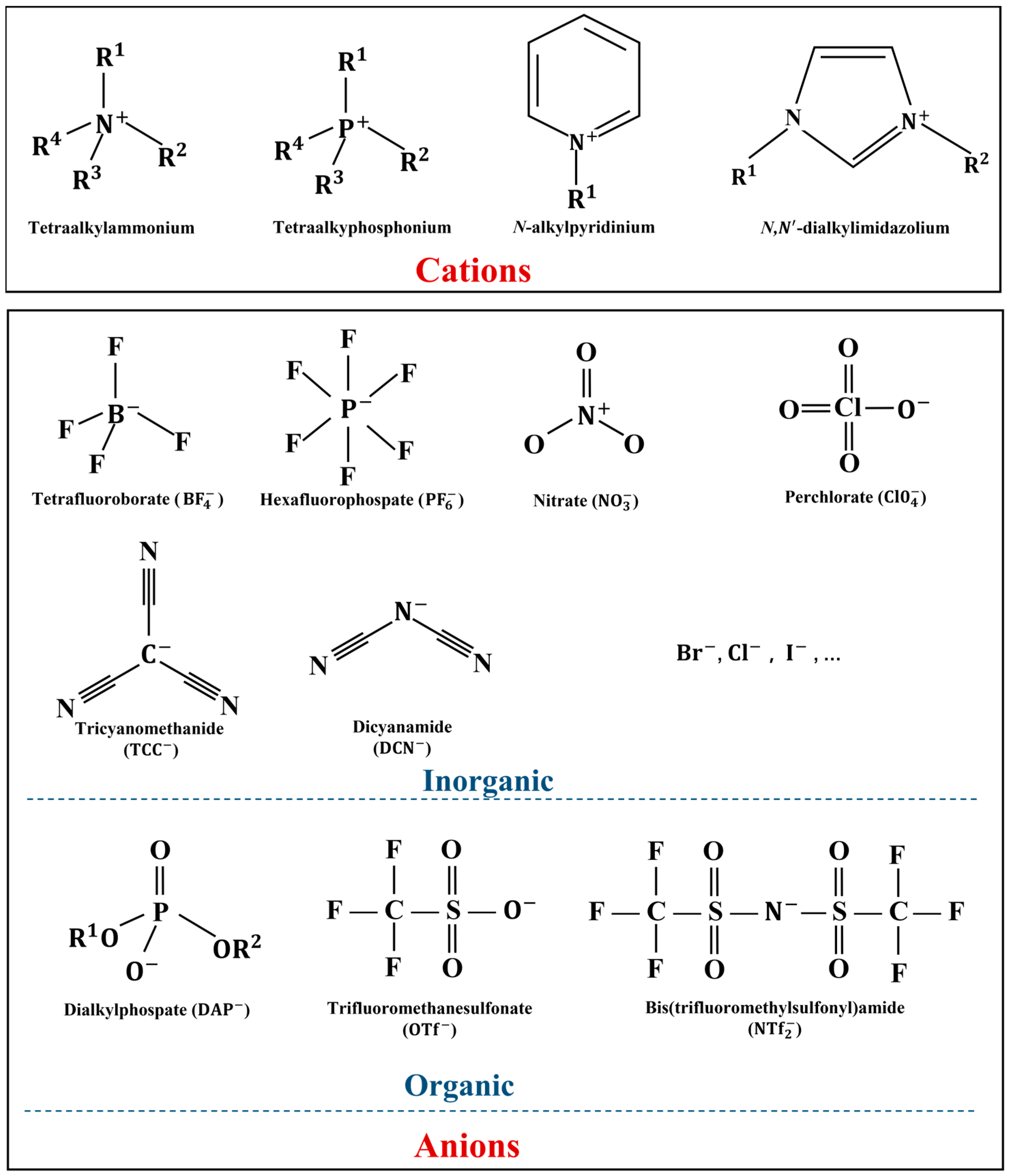


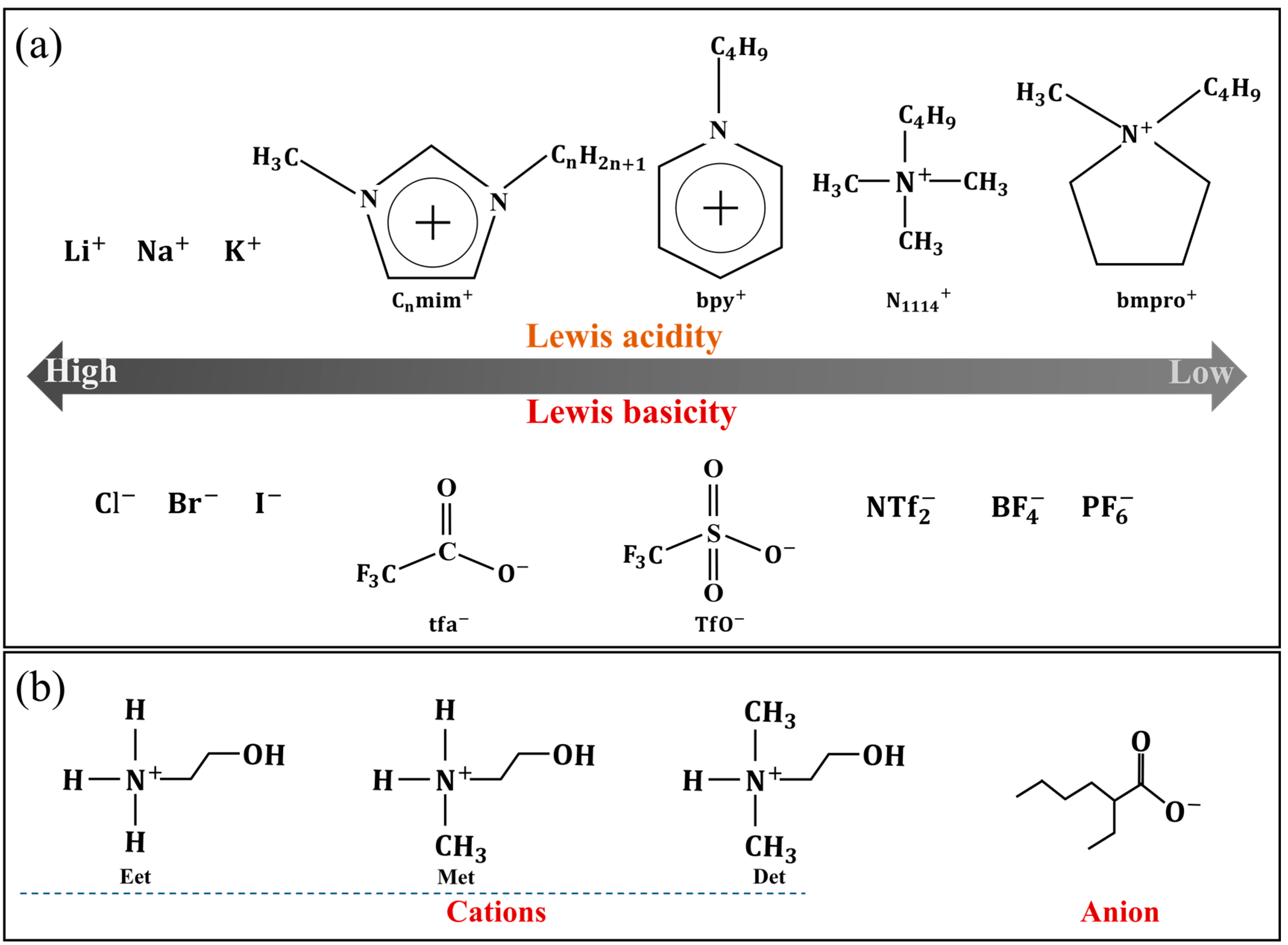
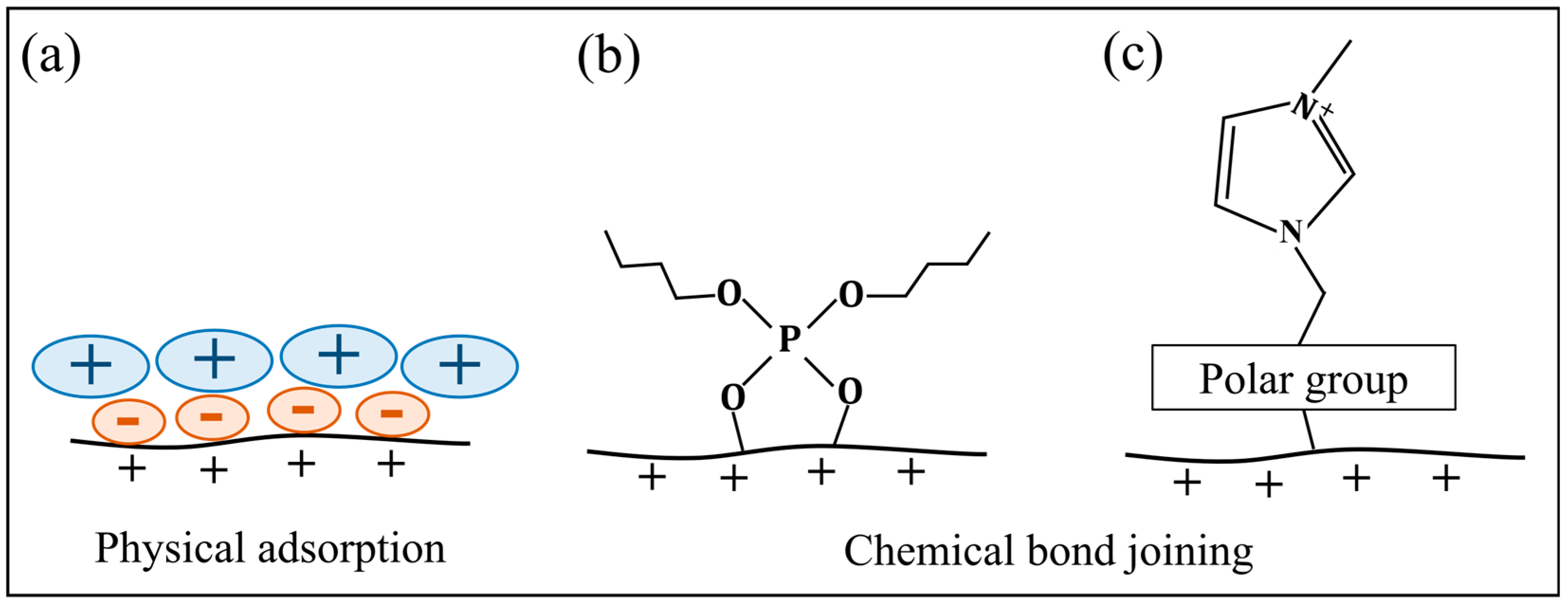


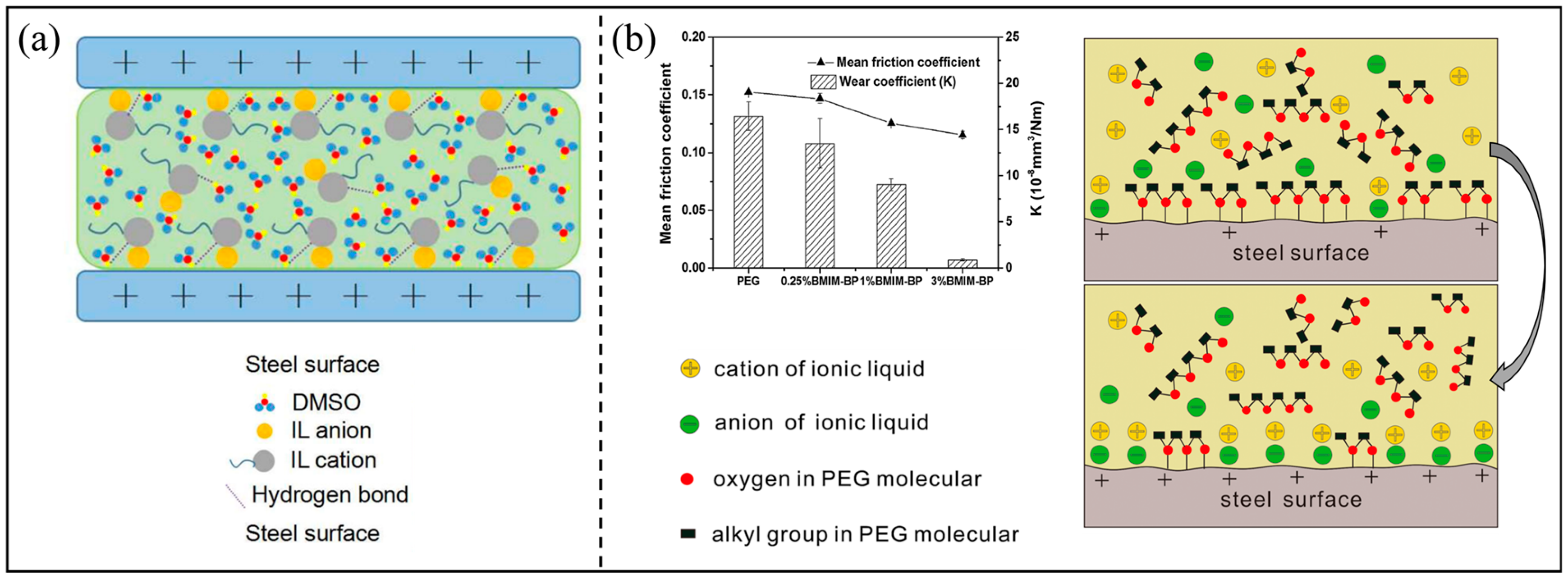


Disclaimer/Publisher’s Note: The statements, opinions and data contained in all publications are solely those of the individual author(s) and contributor(s) and not of MDPI and/or the editor(s). MDPI and/or the editor(s) disclaim responsibility for any injury to people or property resulting from any ideas, methods, instructions or products referred to in the content. |
© 2024 by the authors. Licensee MDPI, Basel, Switzerland. This article is an open access article distributed under the terms and conditions of the Creative Commons Attribution (CC BY) license (https://creativecommons.org/licenses/by/4.0/).
Share and Cite
Liu, M.; Ni, J.; Zhang, C.; Wang, R.; Cheng, Q.; Liang, W.; Liu, Z. The Application of Ionic Liquids in the Lubrication Field: Their Design, Mechanisms, and Behaviors. Lubricants 2024, 12, 24. https://doi.org/10.3390/lubricants12010024
Liu M, Ni J, Zhang C, Wang R, Cheng Q, Liang W, Liu Z. The Application of Ionic Liquids in the Lubrication Field: Their Design, Mechanisms, and Behaviors. Lubricants. 2024; 12(1):24. https://doi.org/10.3390/lubricants12010024
Chicago/Turabian StyleLiu, Mengmeng, Jing Ni, Caixia Zhang, Ruishen Wang, Qiang Cheng, Weihao Liang, and Zhifeng Liu. 2024. "The Application of Ionic Liquids in the Lubrication Field: Their Design, Mechanisms, and Behaviors" Lubricants 12, no. 1: 24. https://doi.org/10.3390/lubricants12010024






